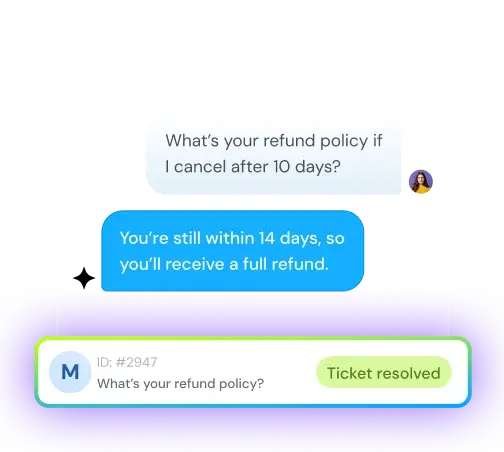Customer service vs customer experience: The essential differences you need to know
Sneha Arunachalam
Aug 14, 2025

Here’s what most businesses get wrong — and it’s costing them.
People throw around "customer service" and "customer experience" like they’re interchangeable. They’re not. And if you don’t understand the difference between customer service and customer experience, you’re missing a massive opportunity to retain customers and grow revenue.
Here's what's really happening: 82% of customers expect their issues resolved immediately, but 80% will ditch your brand after just a few bad interactions. That's not just about fixing problems — it's about how people feel about your entire business.
Think of it like this: customer service is what happens when someone calls for help. Customer experience is everything else — your website, your emails, even how easy it is to find your phone number. Both matter, but they work in completely different ways.
Companies that understand the difference between customer service and customer experience are six times more likely to hit their retention goals.
Why? Because 75% of customers will pay more for better experiences, and 77% stay longer when their issues are handled well. Whether it’s speed (which 60% of people care about) or simply showing empathy (nearly half expect it), both pieces shape how your brand is perceived.
We'll break down exactly what sets these apart and how they work together to keep customers coming back. Because when you get both right, you don't just solve problems — you build relationships that last.
What is customer service?
Customer service is the help you give customers when they need it. Sounds simple, right? But here's the thing — it's way more than just answering phones and fixing problems.
Good customer service starts before someone even buys from you. Maybe they have questions about your product, need help choosing between options, or want to know about shipping. After they buy, they might need technical support, have billing questions, or want to return something. All of that falls under customer service.
Definition and scope
Customer service covers every direct interaction where you're helping a customer solve something. Whether that's through phone, email, chat, social media, or any other channel they prefer.
The key word here is "direct." Someone reaches out, and you respond. It's different from customer support, which usually focuses on post-purchase technical issues. Customer service is bigger — it's about the entire relationship.
Key characteristics of good customer service
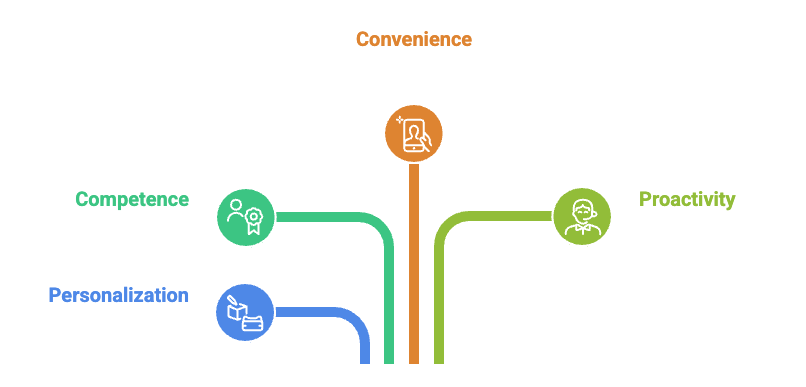
Four things separate great customer service from the rest: personalization, competence, convenience, and proactivity.
Personalization means treating people like humans, not ticket numbers. Show them you actually care about their specific situation.
Competence is huge — your team needs to know your products inside and out, plus have the authority to actually fix things. Nobody wants to get bounced around between five different people.
Convenience means meeting customers where they are. If they want to text you, let them text. If they prefer email, make that easy too.
Proactivity is reaching out before problems become disasters. Like when your website's going down for maintenance — tell people ahead of time.
You also need the basics: empathy, clear communication, patience, problem-solving skills, and actually listening to what people are saying.
Common support channels used
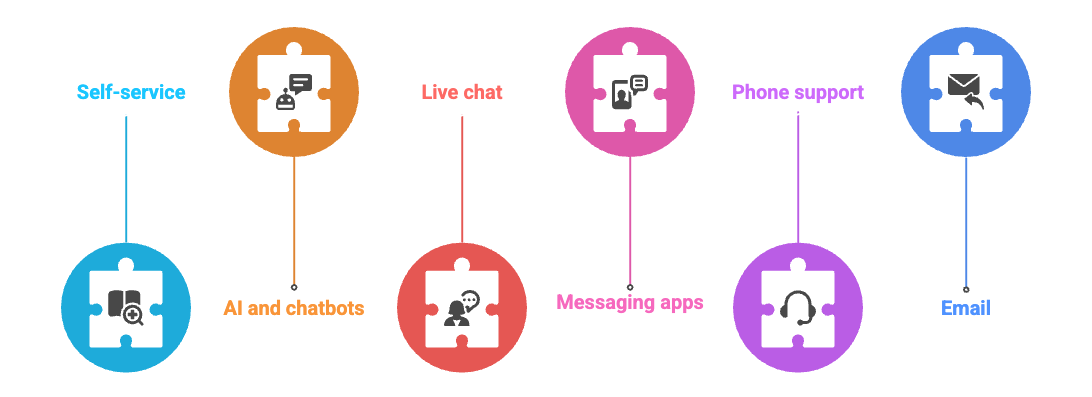
Most customers don't care which channel they use — they just want their problem solved fast. Smart companies offer multiple options because high-performers typically use more channels than everyone else.
Self-service works great for simple stuff. Knowledge bases and customer portals handle 54% of customer issues on their own. Plus, 61% of people actually prefer fixing things themselves when it's straightforward.
AI and chatbots can handle the repetitive questions 24/7, freeing up your human agents for the complex stuff.
Live chat is perfect for quick questions. Nearly 90% of top-performing companies offer it, compared to just 60% of underperformers. One agent can help multiple customers at once, which cuts down wait times.
Messaging apps like WhatsApp and Facebook Messenger are getting popular fast — 79% of companies use them now, up from 70% just a few years ago.
Phone support still matters for complicated issues. Modern systems connect with your CRM so agents can see the customer's full history.
Email is offered by 90% of companies. People can reach out when it's convenient for them, and you've got a record of everything.
Most companies do well with 3-5 core channels. The trick is picking the ones your customers actually want to use.
What is customer experience?
Here's the thing — customer experience isn't just about that one phone call or email. It's every single thing someone thinks and feels about your brand, from the moment they first hear about you to years down the road.
Definition and broader scope
Customer experience covers the whole relationship. Not just when someone needs help, but when they're browsing your website, reading your emails, or even telling their friends about you. It's that complete picture of how people feel about doing business with you.
The numbers back this up: 73% of customers point to experience as a major factor in their buying decisions, right behind price and product quality. Nearly 80% of American consumers want speed, convenience, knowledgeable help, and friendly service — basically, they want the whole thing to work smoothly.
Customer service handles the direct interactions. Customer experience? That's everything else — your website design, your checkout process, how easy it is to find information, even how your building looks if you have a physical location. The key difference is that CX touches every part of your business, not just the support team.
Touchpoints across the customer journey
Every interaction someone has with your brand is a touchpoint. Before they buy, during the purchase, and long after — each moment shapes how they feel about you.
These touchpoints split into two main categories:
- Online touchpoints: Your website, apps, social media, digital ads, text messages, chatbots, emails, and online reviews
- Offline touchpoints: Phone calls, face-to-face conversations, physical stores, events, conferences, and direct mail
Here's why this matters: one study found that customer satisfaction with health insurance is 73% more likely when the entire journey works well, not just individual moments. People notice when things flow together seamlessly.
You can gather feedback at each touchpoint to spot exactly where things go wrong and fix them at the moments that matter most. Customers expect consistency across all channels — they don't want to repeat their story every time they switch from chat to email to phone.
The role of people, process, and product
Think of customer experience like a three-legged stool — people, process, and product all need to work together. If one leg is wobbly, the whole thing falls over.
People need the right training and the power to actually solve problems. This isn't just your customer-facing team — it includes suppliers, partners, and anyone who touches the customer journey. Without skilled, empowered employees who can make decisions, even the best systems don't work.
Process keeps everything consistent and efficient. A good process works the same way every time, grows with your business, and gets better over time. Without solid processes, even talented people can't deliver consistently. Process analysis helps you find bottlenecks and friction points before they frustrate customers.
Product — your actual offerings, location, design, and pricing — has to solve real problems. The best people and processes can't save a product that misses the mark. Your offerings need to actually help customers accomplish what they're trying to do.
The three elements depend on each other completely. Change one, and you'll affect the other two. Always ask yourself: "When I change any element, what's the impact on my organization's customer experience?"
Customer service vs customer experience: Key differences
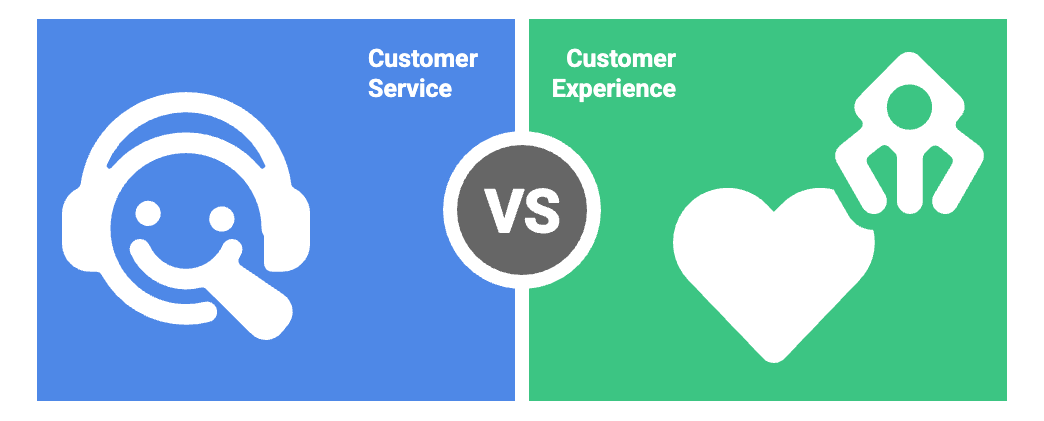
Now that we've covered what each one actually is, here's where things get interesting. These aren’t just two names for the same thing — they function in completely different ways. And that’s exactly where the difference between customer service and customer experience comes in.
1. Scope and timing
Customer service happens in moments. Someone calls, you help them, problem solved. It's about specific interactions through your support channels — phone calls, emails, live chats.
Customer experience is the whole story. From the first time someone hears about your brand to years after they've bought from you, every single touchpoint matters. Your website, your packaging, even how long it takes to load your checkout page.
One is a snapshot. The other is the entire photo album.
2. Proactive vs reactive approach
Here's a big one: customer service waits for problems to show up. Someone emails you about a broken product, you fix it. You're basically playing defense.
Customer experience works the opposite way. You're mapping out journeys, spotting friction points, and smoothing things out before customers even know there's a problem. Through journey mapping and feedback collection, you're preventing issues rather than just fixing them.
Great CX actually reduces the need for customer service calls. When everything works smoothly, people don't need to contact support in the first place.
3. Ownership across teams
More than 5,000 organizations worldwide now have dedicated CX leaders, and nearly half report directly to the CEO. That tells you something.
Customer service lives in your support team. Sure, other people might talk to customers sometimes, but your support agents own the problem-solving.
Customer experience? That's everyone's job. Marketing shapes first impressions, sales handles the buying process, product development creates what people actually use, and yes, support handles the problems. When CX works, every department is pulling in the same direction.
4. Metrics used to measure each
The scorecards look totally different:
Customer service metrics focus on individual interactions — CSAT scores, how fast you respond, whether you fix things on the first try.
Customer experience metrics paint the bigger picture — Net Promoter Score, how much customers spend over time, whether they stick around or leave.
Some large companies with revenue exceeding $1 billion track more than 50 CX metrics — sometimes as many as 200 — spread across different departments. That's a lot of moving parts.
5. Control and influence
You control your customer service completely. Response times, agent training, how problems get solved — that's all you.
Customer experience? Not so much. You can influence a lot, but competitors, market trends, and individual customer preferences all play a role in how people feel about your brand. You're working with more variables you can't control.
Understanding these differences helps you build strategies that actually work for both. Because when you get the relationship right, both customer service and experience start working together instead of against each other.
Why both customer service and customer experience matter
The money speaks for itself. Just a 5% bump in customer retention can boost profits by 25% to 95%. That's not a small change — customers spend 140% more and stick around for up to six years when they rate your brand highly.
Impact on customer loyalty and retention
Here's what's really happening: 75% of customers will pay more for better experiences, even when cheaper options exist. And 77% stay loyal to businesses that handle their problems well. But here's the flip side — 80% will walk away after multiple bad service experiences.
This loyalty hits your bottom line directly. Companies that make customer service a priority are six times more likely to crush their retention goals. Loyalty program members alone spend 12-18% more than everyone else.
How one affects the other
You can't have one without the other. Great service builds the foundation for positive experiences, and good experiences make service interactions smoother.
The thing is, customers want you to reach out proactively when problems happen. That kind of heads-up approach cuts churn significantly.
Executives often miss this connection — they think product quality only drives loyalty while overestimating how much good service matters. But both pieces need to work together.
Examples of businesses succeeding with both
Some companies get this right:
Zappos built everything around service — free shipping on returns, 365-day return policy, the works. That customer-first mindset made them retail legends.
Amazon nails both sides. Hassle-free returns, price guarantees, and policies designed to build relationships, not just close sales.
Apple keeps it personal with support portals where customers see every product they've bought and get dedicated help. Their NPS of 49 shows it's working.
How to align customer service with customer experience
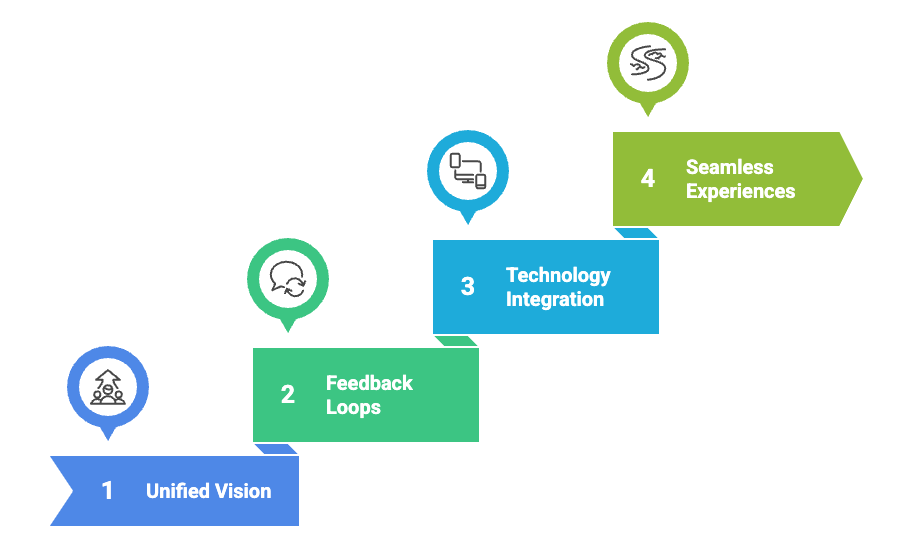
Here's the thing — most companies treat service and experience like separate departments. That's a mistake. Consumers will pay more for better experiences, you need both working together, not against each other.
Train teams with a unified vision
Start with training from day one. Not just your support team — everyone who touches the customer journey needs to understand their role in shaping how people feel about your brand.
Here's what works: include marketing, sales, and even your product team in customer service training. They might not answer phones, but they create the experiences that either make your support team's job easier or harder.
Make sure everyone gets how their work affects the bigger picture. When your website team knows that confusing navigation creates frustrated customers, they'll design differently. When your sales team understands that overpromising leads to angry support calls, they'll set better expectations.
Use feedback loops to improve both
Create a cycle that actually works — collect feedback, spot the patterns, fix what's broken, then tell customers what you changed. This bridges the gap between fixing today's problems and preventing tomorrow's headaches.
Don't just collect feedback and file it away. Close the loop by showing customers their input mattered. Someone complains about your checkout process? Fix it, then email them about the improvement. That turns a negative experience into a story they'll tell their friends.
The key is getting that feedback to the right people. If customers keep complaining about slow shipping, your support team can't fix that — your operations team can.
Use technology that connects everything
Break down those silos between your marketing, sales, and support systems. When your support agent can see that a customer just bought three products last week and has been browsing your help docs, they can have a completely different conversation.
AI tools can handle the routine stuff — password resets, order tracking, basic questions. This frees up your human agents to focus on the complex problems that actually need empathy and creativity.
Record your best interactions and use them as training examples. Nothing teaches good service like hearing how a great agent turned an angry customer into a loyal one.
Create seamless experiences across channels
Think about it from your customer's perspective — they shouldn't have to repeat their story every time they switch from chat to email to phone. Your systems should remember the conversation, not force people to start over.
Map out how customers actually move through your business. Where do they get stuck? Where do they have to repeat information? Those friction points are where you lose people, even if your individual support interactions are great.
When someone can start a conversation on your website, continue it over email, and finish it on the phone without missing a beat, that's when service and experience work together perfectly.
At-a-glance overview of the difference between customer service and customer experience
Aspect | Customer Experience (CX) | Customer Service (CS) |
Definition | The overall perception of a customer’s interactions with your brand | The support provided when a customer has a question or problem |
Scope | End-to-end journey: product, website, emails, packaging, support | One specific touchpoint — usually during issue resolution |
Nature | Proactive: Designed and optimized across the full journey | Reactive: Triggered when a customer reaches out |
Goal | Build long-term loyalty, satisfaction, and emotional connection | Solve problems quickly and effectively |
Who Owns It | Entire company: product, marketing, sales, support, leadership | Primarily the customer support or success team |
Channels | All touchpoints — digital and physical | Email, chat, phone, help desk |
Metrics Used | NPS, CES, churn rate, customer lifetime value | CSAT, first response time, average resolution time |
Example | Easy-to-use website, smooth onboarding, personalized communication | Resolving a billing issue or answering a technical question |
Impact on Loyalty | Shapes emotional connection, long-term retention | Directly affects short-term satisfaction and trust |
Success Looks Like | Customers stay longer, refer others, and feel good about your brand | Customers feel heard, helped, and happy with the resolution |
Conclusion
Here’s the bottom line — customer service and customer experience work as a team, not solo acts. Service handles the immediate problems, experience shapes everything else. You need both working together if you want customers who stick around.
The money talks. Companies that understand the difference between customer service and customer experience see better retention, more loyalty, and bigger profits. Your customers want quick fixes and smooth experiences across every channel. Give them that, and you've got relationships that last.
Success comes down to getting everyone on the same page. Train your whole team with one vision, actually listen to customer feedback, use technology that makes sense, and create support that works seamlessly across channels. Look at Zappos, Amazon, and Apple — they didn't pick one or the other. They mastered both.
Think of great service as your foundation. Everything else builds on top of that. They're different in how they work, who owns them, and how you measure them — and that’s the real difference between customer service and customer experience. But in the end, they're partners in keeping customers happy.
Your long-term success depends on committing to both. When you align them right, you're not just solving today's problems — you're building the kind of loyalty that survives whatever comes next.
Quick summary: Difference between customer service and customer experience explained
Most businesses mistakenly treat customer service and customer experience as interchangeable terms, but this confusion costs them customers and revenue. Understanding the difference between customer service and customer experience is crucial for building lasting relationships and business growth.
• Customer service focuses on direct interactions when customers need help – answering calls, resolving issues, and providing support through various channels. It's reactive, happening in specific moments.
• Customer experience encompasses the entire customer journey – from first brand awareness to years after purchase, including website design, checkout processes, and every touchpoint.
• The difference between customer service and customer experience lies in scope: service handles immediate problems while experience shapes the complete relationship.
• Success requires aligning both through unified team training, feedback loops, connected technology, and seamless cross-channel experiences.
• Companies like Zappos, Amazon, and Apple excel by mastering both elements rather than choosing one over the other.
So this isn't about picking sides – it's about making them work together. Service provides the foundation while experience builds everything else, creating customer loyalty that drives long-term success.
Frequently Asked Questions
Customer Experience (CX) is the entire journey a customer has with your brand — every touchpoint, from your website and emails to your product and post-purchase follow-up. It’s how customers feel about your business as a whole.
Customer Service (CS) is just one part of that journey — usually when a customer reaches out for help or support. It’s reactive, issue-specific, and typically handled by your support team.
The 4 pillars of customer service are the foundational principles that drive great support and long-term customer loyalty. While different companies may phrase them slightly differently, these four consistently show up across top-performing businesses:
1. Speed
Customers want quick resolutions.
More than 60% of customers say fast response time is their top priority in support. Whether it’s replying to a ticket, answering a live chat, or following up on an issue, speed sets the tone for trust.
2. Empathy
Support should feel human.
Customers don’t just want answers — they want to feel heard and understood. Empathy means actively listening, acknowledging their frustration, and responding with care. It's what turns problems into positive moments.
3. Clarity
Clear communication builds confidence.
Jargon-free, honest, and easy-to-follow responses reduce confusion and frustration. Whether it’s explaining a policy or walking someone through a fix, clarity is what makes help actually helpful.
4. Consistency
Customers expect reliable experiences.
Great service isn’t just a one-time thing. It's about delivering the same level of care and quality every time, across every channel — email, chat, phone, or social.
CRM (Customer Relationship Management) is a tool or system used to manage your interactions with customers — tracking data like contact info, purchase history, and support conversations. It's operational and focused on organizing and optimizing customer interactions.
CX (Customer Experience) is the overall perception a customer has of your brand — shaped by every interaction, from your website and product to service and support. It's emotional and focused on how customers feel throughout their journey.
The 30-second rule in customer service refers to the idea that you should acknowledge or respond to a customer within 30 seconds — especially in live channels like chat, phone, or social media.
It’s not about solving the issue right away, but about letting the customer know you’re there and that help is on the way.
- Customer service uses metrics like FRT (First Response Time), ART (Average Resolution Time), and CSAT.
- Customer experience looks at NPS, CES (Customer Effort Score), churn rate, and journey satisfaction.
